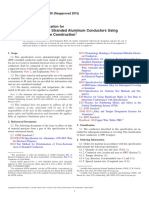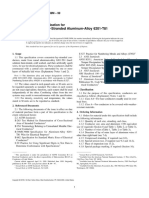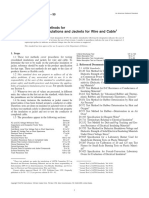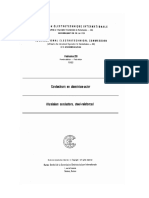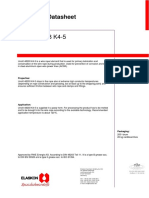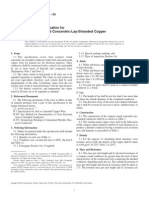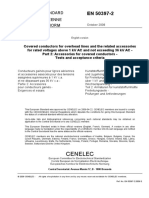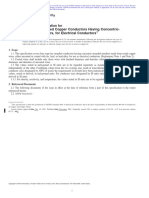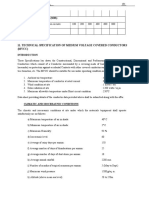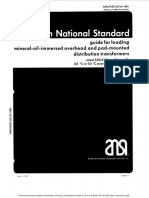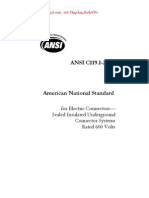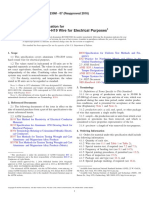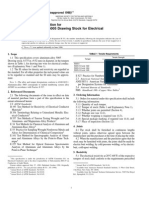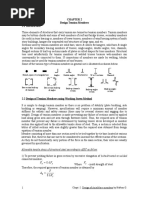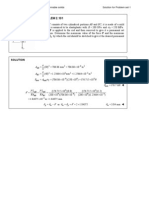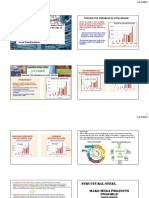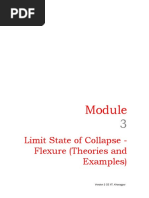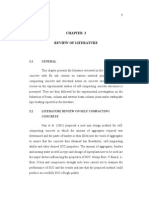Astm B398-02
Astm B398-02
Uploaded by
Pedro M LoCopyright:
Available Formats
Astm B398-02
Astm B398-02
Uploaded by
Pedro M LoOriginal Title
Copyright
Available Formats
Share this document
Did you find this document useful?
Is this content inappropriate?
Copyright:
Available Formats
Astm B398-02
Astm B398-02
Uploaded by
Pedro M LoCopyright:
Available Formats
Designation: B 398/B 398M 02 (Reapproved 2007)
Standard Specification for
Aluminum-Alloy 6201-T81 Wire for Electrical Purposes1
This standard is issued under the fixed designation B 398/B 398M; the number immediately following the designation indicates the year
of original adoption or, in the case of revision, the year of last revision. A number in parentheses indicates the year of last reapproval.
A superscript epsilon (e) indicates an editorial change since the last revision or reapproval.
NOTE 1The alloy and temper designations conform to ANSI H35.1
and H35.1M. Aluminum-alloy 6201 corresponds to unified numbering
system alloy A96201 in accordance with Practice E 527.
3. Terminology
3.1 Definitions of Terms Specific to This Standard:
3.1.1 lotA group of production units, up to 30 000 lb [15
metric tons] of mass, of one type and size of wire, which was
produced during the same time period, under similar production conditions, and is presented for acceptance at the same
time (Explanatory Notes 1 and 2).
3.1.2 production unitA coil, reel, spool, or other package
of wire that represents a single usable length.
3.1.3 sampleThe production unit or units from which a
test specimen or specimens has been removed, and which is
considered to have properties representative of the lot.
3.1.4 specimenA length of wire removed for test purposes.
1.2 The values stated in inch-pound or SI units are to be
regarded separately as standard. The values in each system are
not exact equivalents; therefore, each system shall be used
independently of the other. Combining values from the two
systems may result in nonconformance with the specification.
1.2.1 For density, resistivity and temperature, the values
stated in SI units are to be regarded as standard.
2. Referenced Documents
2.1 The following documents of this issue in effect on date
of material purchase form a part of this specification to the
extent referenced herein.
2.2 ASTM Standards: 2
B 193 Test Method for Resistivity of Electrical Conductor
Materials
B 557 Test Methods for Tension Testing Wrought and Cast
Aluminum- and Magnesium-Alloy Products
B 557M Test Methods for Tension Testing Wrought and
Cast Aluminum- and Magnesium-Alloy Products [Metric]
B 830 Specification for Uniform Test Methods and Frequency
E 527 Practice for Numbering Metals and Alloys in the
Unified Numbering System (UNS)
2.3 ANSI Standard:3
ANSI H35.1 American National Standard for Alloy and
4. Ordering Information
4.1 Orders for material under this specification shall include
the following information:
4.1.1 Quantity of each size,
4.1.2 Wire size: diameter in inches or in millimetres (see
11.1),
4.1.3 Special tension test, if required (see 7.2 and 7.3),
4.1.4 Frequency of bending test (see 8.2),
4.1.5 Special jointing procedures, if permitted (see 12.2),
4.1.6 Place of inspection (see 15.2),
4.1.7 Package size and type (see 16.1), and
4.1.8 Special package marking, if required (see 16.4).
5. Material and Manufacture
5.1 The aluminum alloy used shall be of such quality that
wire produced from it can comply with the requirements as to
chemical composition, tensile and elongation properties, bending properties, and electrical resistivity prescribed in this
specification.
This specification is under the jurisdiction of ASTM Committee B01 on
Electrical Conductors and is the direct responsibility of Subcommittee B01.07 on
Conductors of Light Metals.
Current edition approved Oct. 1, 2007. Published October 2007. Originally
approved in 1963. Last previous edition approved in 2002 as B 398 02.
2
For referenced ASTM standards, visit the ASTM website, www.astm.org, or
contact ASTM Customer Service at service@astm.org. For Annual Book of ASTM
Standards volume information, refer to the standards Document Summary page on
the ASTM website.
3
Available from American National Standards Institute (ANSI), 25 W. 43rd St.,
4th Floor, New York, NY 10036, http://www.ansi.org.
4
Available from National Technical Information Service (NTIS), 5285 Port
Royal Rd., Springfield, VA 22161, http://www.ntis.gov.
Copyright ASTM International, 100 Barr Harbor Drive, PO Box C700, West Conshohocken, PA 19428-2959, United States.
1
Copyright by ASTM Int'l (all rights reserved); Tue Jul 14 05:06:48 EDT 2009
Downloaded/printed by
(Book Supply Bureau) pursuant to License Agreement. No further reproductions authorized.
SUPPLIED BY BSB UNDER LICENCE FROM ASTM FOR POWER GRID CORPORATION OF INDIA LIMITED - GURGAON
Temper Designation Systems for Aluminum
ANSI H35.1M American National Standard Alloy and Temper Designation Systems for Aluminum [Metric]
2.4 NIST Standard:4
Handbook 100 Copper Wire Tables
1. Scope
1.1 This specification covers aluminum-alloy 6201-T81
(hard: solution heat-treated, cold worked, and artificially aged)
round wire for electrical purposes.
B 398/B 398M 02 (2007)
TABLE 2 Tensile Requirements
6. Chemical Composition
6.1 The wire shall be made from aluminum alloy 6201 as
designated in ANSI H35.1 and H35.1M. The material shall
conform to the chemical composition prescribed in Table 1.
Diameter, in. (mm)
Over
0.1280 (3.25)
0.0610 (1.50)
7. Tensile Properties
7.1 The heat-treated, drawn, and artificially aged wire when
sampled in accordance with Section 14 of this specification and
tested in accordance with Test Methods B 557 and B 557M
shall conform to the tensile requirements prescribed in Table 2
(Explanatory Note 3).
7.2 When requested by the purchaser, tension tests shall be
made on specimens of heat-treated, drawn, and artificially aged
wire containing joints made in the wire after heat treatment and
prior to final drawing. Such tests shall show not less than 90 %
of the minimum strength specified in Table 2 for individual
test.
7.3 When requested by the purchaser, tension tests shall be
made on specimens of heat-treated, drawn, and artificially aged
wire containing joints made in the finished wire or during the
final drawing as permitted in 12.2. Such tests shall show the
tensile strength to be not less than 42 ksi (290 MPa) for
cold-pressure welds and for electric-butt, cold-upset welds and
not less than 15 ksi (100 MPa) for electric-butt welds.
Electric-butt welds in addition shall show a minimum elongation of 6 % in 10 in. (250 mm).
Material
Volume Conductivity
% IACS
Copper
Aluminum
100
61.0
53.5
52.5
Resistivity ConstantsA
Volume
Vcmil/ft (Vmm2/m)
10.371 (0.017241)
17.002 (0.028265)
19.385 (0.032227)
19.755 (0.032841)
A
The equivalent resistivity values for 100 % IACS (soft copper) were each
computed from the fundamental IEC value (158 Vmm2m) using conversion factors
each accurate to at least seven significant figures. Corresponding values for other
conductivities (aluminum) were derived from these by multiplying by the reciprocal
of the conductivity ratios accurate to at least seven significant figures.
11. Diameter and Permissible Variations
11.1 The diameter of the wire shall be expressed in decimal
fractions of an inch using four places of decimals or in
millimetres using two places of decimals.
11.2 Ten percent, but not less than five coils or spools (or all
if the lot is less than five) from any lot of wire shall be gaged
at three places. If the material is in coil form, one gaging shall
be made near each end and one near the middle.
11.3 The permissible variations in diameter are as follows:
Specified Diameter, in. (mm)
0.1878 to 0.1000
(4.75 to 2.55), incl
Under 0.1000 to 0.0612
(2.55 to 1.50), incl
Permissible Variations of Mean
Diameter from Specified Diameter,
plus and minus
1%
0.0010 in. (0.03 mm)
12. Joints
12.1 Unless otherwise specified at the time of placing the
order, wire shall be supplied in one continuous length of reel,
coil, or spool. Joints may be made in the drawing stock or wire
after heat treatment and prior to final drawing by electric-butt
welding, by cold-pressure welding, or by electric-butt, coldupset welding in accordance with good commercial practice.
Unless otherwise specified, no joints shall be made during final
drawing or in the finished wire.
12.2 If agreed upon between the manufacturer and the
purchaser, joints may be made during final drawing or in the
finished wire by cold-pressure welding, by electric-butt, coldupset welding, or by electric-butt welding. Following welding,
electric-butt welds shall be annealed for a distance of at least 6
in. (150 mm) on each side of the weld. Not more than 10 % of
the reels, coils, or spools shall contain such joints and no joint
shall be closer than 50 ft (15 m) to another or to either end of
the wire, and not more than two such joints shall be present in
any reel, coil, or spool of the nominal specified mass.
TABLE 1 Chemical RequirementsA
Composition, %
0.10
0.50
0.500.9
0.03
0.60.9
0.10
0.03
0.06
0.03
0.10
remainder
A
Analysis shall regularly be made only for the elements specified in this table.
If, however, the presence of other elements is suspected or indicated in amounts
greater than the specified limits, further analysis shall be made to determine that
these elements are not present in amounts in excess of the specified limits for
other elements.
2
Copyright by ASTM Int'l (all rights reserved); Tue Jul 14 05:06:48 EDT 2009
Downloaded/printed by
(Book Supply Bureau) pursuant to License Agreement. No further reproductions authorized.
SUPPLIED BY BSB UNDER LICENCE FROM ASTM FOR POWER GRID CORPORATION OF INDIA LIMITED - GURGAON
10. Density
10.1 For the purpose of calculating mass, mass per unit
length, mass cross sections, etc., the density of aluminum-alloy
6201 shall be taken as 2690 kg/m3(0.097 lb/in.3) at 20C.
9. Resistivity
9.1 Electrical resistivity, determined on samples selected in
accordance with Section 14 of this specification and tested in
accordance with Test Method B 193, shall not exceed 0.032841
Vmm2/m at 20C (68F) (Explanatory Note 2 and Table 3).
Copper, max
Iron, max
Silicon
Manganese, max
Magnesium
Zinc, max
Chromium, max
Boron, max
Other elements, each, max
Other elements, total, max
Aluminum
Elongation in 10
in. (250 mm) for
Individual Tests,
min, %
3.0
3.0
TABLE 3 Equivalent Resistivity Values at 20C (68F)A
8. Bending Properties
8.1 The wire shall be free of brittleness as evidenced by its
ability to be coiled or looped around its own diameter either
with or without a mandrel. No fracture shall occur. Slight
surface checks shall not constitute cause for rejection.
8.2 Any coil or reel may be tested in accordance with 8.1,
but the frequency of production sampling and testing shall be
by agreement between the manufacturer and the purchaser.
Element
Through
0.1878 (4.75)
0.1280 (3.25)
Tensile Strength, min
Average
Individual
for a lot
Tests
ksi (MPa)
ksi (MPa)
46 (315)
44 (305)
48 (330)
46 (315)
B 398/B 398M 02 (2007)
13.1 The wire shall be free of all imperfections not consistent with good commercial practice.
14. Sampling, Testing, and Conformance Criteria
14.1 SamplingFour test specimens shall be obtained, one
from each of four production units or in accordance with
Specification B 830 (see Explanatory Note 2).
14.2 Tensile strength, elongation, and resistivity:
14.2.1 Test Methods:
14.2.1.1 Tensile strength and elongation may be determined
simultaneously. Obtain the tensile strength, using Test Methods
B 557, by dividing the maximum load resisted by the tensile
specimen, with the tensile stress to be expressed in kips (1000
lbf.) per square inch (ksi). Elongation is the percent increase in
length of the tensile specimen as measured between gage
marks originally spaced 10 in. (254 mm) apart on the specimen. Elongation measurements are not required for wire less
than 0.0500 in. in diameter. Should any part of the fracture take
place outside the elongation gage lines, or if examination of the
tensile specimen indicates a flaw, the values obtained may not
be representative and a test on another section of the specimen
may be run.
14.2.1.2 Determine the electrical resistivity using Test
Method B 193.
14.2.2 Test ResultsA numerical average for the tensile
strength, elongation, and resistivity of the four specimens shall
be calculated and shall be considered the lot average.
14.2.3 Conformance CriteriaTo be considered in conformance, the lot average test results shall meet the average
for a lot requirements of Tables 1 and 2, and the test results of
each specimen shall meet the individual tests requirements of
Tables 2 and 3 unless otherwise specified.
14.2.3.1 If the lot average results are in conformance, and
all of the individual specimen results are in conformance, the
lot shall be considered in conformance.
14.2.3.2 If the lot average result for one or more of the
tested properties is not in conformance and one or more of the
individual specimen results is also not in conformance, the lot
shall be considered not in conformance.
14.2.3.3 If the lot average results are in conformance, but
one or more of the individual specimen results are not in
conformance, the lot shall be considered in conformance
except that the production unit or units represented by the
nonconforming specimen or specimens shall be rejected.
14.2.3.4 If the lot average results for one or more of the
tested properties are not in conformance, but all the individual
specimen results are in conformance, then additional test
specimens and tests shall be required as follows:
(1) An additional six test specimens shall be obtained, one
each from six production units other than the four originally
sampled. Test shall be run on the six additional specimens, and
a numerical average of the ten tested specimens shall be
calculated and considered the lot average.
15. Inspection
15.1 Unless otherwise specified in the purchase contract, the
manufacturer shall be responsible for the performance of all
inspection and testing requirements specified.
15.2 All tests and inspections shall be made at the place of
manufacture unless otherwise agreed upon between the manufacturer and the purchaser.
15.3 The manufacturer shall afford the purchaser reasonable
access to the manufacturers facilities consistent with the
purchasers need to ensure compliance with this specification.
15.4 Unless otherwise agreed upon between the manufacturer and the purchaser, conformance of the wire to the
requirements specified in Sections 7, 8, 9, 11, and 13 shall be
determined by sampling in accordance with Section 14 of each
lot of wire presented for acceptance.
15.5 The manufacturer shall, if requested prior to inspection
and testing, certify that the product as a whole was made under
such uniform conditions that compliance with the requirements
of this specification can be determined by sampling, inspections, and tests performed in accordance with Section 14
(Explanatory Note 2).
16. Packaging, and Package Marking
16.1 Package sizes shall be agreed upon between the manufacturer and the purchaser in the placing of individual orders.
16.2 Unless otherwise specified, the wire shall be supplied
in one continuous length on each reel, coil, or spool.
16.3 The wire shall be protected against damage in ordinary
handling and shipping.
16.4 Each package shall bear a tag showing the manufacturers name or trademark, alloy and temper, size, and weight
of material. If additional information is to be required on the
tags, it shall be arranged with the manufacturer at the time of
purchase.
17. Keywords
17.1 aluminum alloy 6201-T81 wire; aluminum alloy wire;
aluminum wire; electrical conductor-aluminum; electrical conductors
3
Copyright by ASTM Int'l (all rights reserved); Tue Jul 14 05:06:48 EDT 2009
Downloaded/printed by
(Book Supply Bureau) pursuant to License Agreement. No further reproductions authorized.
SUPPLIED BY BSB UNDER LICENCE FROM ASTM FOR POWER GRID CORPORATION OF INDIA LIMITED - GURGAON
(2) If the ten specimen lot average results are in conformance, and all ten of the individual specimen results are in
conformance, the lot shall be considered in conformance.
(3) If the ten specimen lot average results for one or more
of the tested properties are not in conformance, or if one or
more of the ten individual specimen results are not in conformance, the lot shall be considered not in conformance.
(4) In the event a lot is rejected in accordance with 14.2.3.2
or (3), production units making up that lot may be individually
tested. Acceptance of individual production units from a
rejected lot shall be dependent on the individual specimen test
results meeting the average for a lot requirements of Tables
2 and 3.
14.3 Bending (brittleness)Specimens from any production unit may be tested, with the frequency of sampling and
testing to be agreed upon between the manufacturer and the
purchaser.
13. Workmanship, Finish and Appearance
B 398/B 398M 02 (2007)
EXPLANATORY NOTES
NOTE 1A lot should comprise material taken from a product regularly
meeting the requirements of this specification. Inspection of lots of less
than 5000 lb [2500 kg] of wire cannot be justified economically. For small
lots of less than 5000 lb [2500 kg] the purchaser may agree to the
manufacturers regular inspection of the product as a whole as evidence of
acceptability of such small lots.
NOTE 2Cumulative historic results secured on the product of a single
manufacturer indicating a record of continual conformance of that product
with the requirements of this specification are necessary to ensure that the
sample can be assumed representative of the lot, and that the conformance
criteria will largely ensure compliance of the lot with this specification.
The sample sizes and conformance criteria are applicable only to lots
produced by manufacturers that meet this requirement.
NOTE 3The speed of testing can affect the results of the tensile
strength and elongation test. In order to ensure uniformity in the test
method and valid applicability of the test results to the conformance
criteria, it is recommended that the rate of separation of the heads of the
tensile test machine not exceed 0.5 in. for each inch [0.5 mm for each mm]
of length between grips/min.
NOTE 4Relationships that may be useful in connection with the
values of electrical resistivity are shown in Table 2. Resistivity units are
based on the International Annealed Copper Standard (IACS) adopted by
IEC in 1913, which is 1/58 Vmm2/m at 20C [68F] for 100 %
conductivity. The value of 0.017241 V2/m at 20C [68F] is the
international equivalent of volume resistivity of annealed copper equal to
100 % conductivity. A complete discussion of this subject is contained in
NBS Handbook 100. The use of five significant figures in expressing
resistivity does not imply the need for greater accuracy of measurement
than that specified in Test Method B 193. The use of five significant
figures is required for reasonably accurate reversible conversion from one
set of resistivity units to another. The equivalent resistivity values in Table
3 were derived from the fundamental IEC value (1/58 Vmm2/m)
computed to seven significant figures and then rounded to five significant
figures.
ASTM International takes no position respecting the validity of any patent rights asserted in connection with any item mentioned
in this standard. Users of this standard are expressly advised that determination of the validity of any such patent rights, and the risk
of infringement of such rights, are entirely their own responsibility.
This standard is copyrighted by ASTM International, 100 Barr Harbor Drive, PO Box C700, West Conshohocken, PA 19428-2959,
United States. Individual reprints (single or multiple copies) of this standard may be obtained by contacting ASTM at the above
address or at 610-832-9585 (phone), 610-832-9555 (fax), or service@astm.org (e-mail); or through the ASTM website
(www.astm.org).
4
Copyright by ASTM Int'l (all rights reserved); Tue Jul 14 05:06:48 EDT 2009
Downloaded/printed by
(Book Supply Bureau) pursuant to License Agreement. No further reproductions authorized.
SUPPLIED BY BSB UNDER LICENCE FROM ASTM FOR POWER GRID CORPORATION OF INDIA LIMITED - GURGAON
This standard is subject to revision at any time by the responsible technical committee and must be reviewed every five years and
if not revised, either reapproved or withdrawn. Your comments are invited either for revision of this standard or for additional standards
and should be addressed to ASTM International Headquarters. Your comments will receive careful consideration at a meeting of the
responsible technical committee, which you may attend. If you feel that your comments have not received a fair hearing you should
make your views known to the ASTM Committee on Standards, at the address shown below.
You might also like
- GSCC021 MV Aerial Covered Conductor - Rev01Document20 pagesGSCC021 MV Aerial Covered Conductor - Rev01rasoolNo ratings yet
- B 549 - 13 PDFDocument8 pagesB 549 - 13 PDFTuanbk Nguyen0% (1)
- Compact Round Stranded Aluminum Conductors Using Single Input Wire ConstructionDocument4 pagesCompact Round Stranded Aluminum Conductors Using Single Input Wire ConstructionHanh-Trang DangNo ratings yet
- ASTM B228 Standard Specification For Concentric-Lay-Stranded Copper-Clad Steel ConductorsDocument4 pagesASTM B228 Standard Specification For Concentric-Lay-Stranded Copper-Clad Steel Conductorsjucag66No ratings yet
- Astm B399Document5 pagesAstm B399rcarrasco07No ratings yet
- B 3Document5 pagesB 3manuel floresNo ratings yet
- Astm B 263Document3 pagesAstm B 263chaivatNo ratings yet
- Astm B 606 - 98Document3 pagesAstm B 606 - 98Fernando AngioliniNo ratings yet
- Astm B830 97Document3 pagesAstm B830 97Mary MaNo ratings yet
- Composite Overhead ConductorsDocument21 pagesComposite Overhead ConductorsEnrique Garcia100% (1)
- Trefoil and Single Cable Cleats Type SmartcleatDocument12 pagesTrefoil and Single Cable Cleats Type SmartcleatfndprojectNo ratings yet
- Concentric-Lay-Stranded Aluminum 1350 Conductors: Standard Specification ForDocument11 pagesConcentric-Lay-Stranded Aluminum 1350 Conductors: Standard Specification ForAlexis AguillonNo ratings yet
- Standard Test Methods For Crosslinked Insulations and Jackets For Wire and CableDocument25 pagesStandard Test Methods For Crosslinked Insulations and Jackets For Wire and CableLina Rocio Gutierrez BarraganNo ratings yet
- En Standard For Maintaince of Covered ConductorDocument12 pagesEn Standard For Maintaince of Covered ConductorAnkur AgrawalNo ratings yet
- The Effect of Soil and Cable Backfill Thermal ConductivityDocument6 pagesThe Effect of Soil and Cable Backfill Thermal ConductivitymiguelpaltinoNo ratings yet
- Aluminum Conductor Steel Reinforced Trapezoidal Wire (ACSR/TW)Document5 pagesAluminum Conductor Steel Reinforced Trapezoidal Wire (ACSR/TW)manohargud100% (1)
- Advances in EHV Extruded CablesDocument8 pagesAdvances in EHV Extruded CablesA. HassanNo ratings yet
- Cold Shrink Technology For CablesDocument8 pagesCold Shrink Technology For Cablesnitin369No ratings yet
- Iec-209-Aluminium Conductors, Steel-ReinforcedDocument16 pagesIec-209-Aluminium Conductors, Steel-ReinforcedLasitha FernandoNo ratings yet
- Alternating Current (Ac) Resistance of Helically Stranded ConductorsDocument59 pagesAlternating Current (Ac) Resistance of Helically Stranded ConductorsSahilMirza100% (1)
- Section Four - Medium Voltage Tr-Xlpe Cables: Explanatory Information 2-13Document56 pagesSection Four - Medium Voltage Tr-Xlpe Cables: Explanatory Information 2-13Terex14253No ratings yet
- AEI LinkeX Cross-Linked Polyethylene Insulated Power CablesDocument42 pagesAEI LinkeX Cross-Linked Polyethylene Insulated Power Cablesjohn9999999100% (1)
- Cable Cleat Catalogue 2014Document28 pagesCable Cleat Catalogue 2014carlosmandopintoNo ratings yet
- STACIRDocument2 pagesSTACIRSpring HaruNo ratings yet
- Cable OpgwDocument6 pagesCable OpgwJose Cisneros ManchegoNo ratings yet
- Thermally Upgraded PaperDocument5 pagesThermally Upgraded Paperamulya00428100% (1)
- PHD Thesis 13.11.2018 P. CicheckiDocument225 pagesPHD Thesis 13.11.2018 P. CicheckiCésar Díaz LiberonaNo ratings yet
- Aged Acsr Conductors Testing Procedures For Conductors and LinDocument7 pagesAged Acsr Conductors Testing Procedures For Conductors and LinpabloNo ratings yet
- Covered Conductor Systems For Distribution Report Number 5925Document73 pagesCovered Conductor Systems For Distribution Report Number 5925CMCP100% (1)
- Astm B8 99Document4 pagesAstm B8 99Raul EirisNo ratings yet
- Water Tree Cable JointsDocument151 pagesWater Tree Cable JointsSellappan MuthusamyNo ratings yet
- Fiber Stress For Wood PolesDocument42 pagesFiber Stress For Wood PolesbcbianNo ratings yet
- KEI Cables-1Document72 pagesKEI Cables-1chandu1821No ratings yet
- GraseDocument2 pagesGrasetony mejiaNo ratings yet
- APPENDIX A.1 - Ojas Infra - Chichester SS - MV Cable TDSDocument4 pagesAPPENDIX A.1 - Ojas Infra - Chichester SS - MV Cable TDSSanjay GadhaveNo ratings yet
- Gost 839-1980 PDFDocument1 pageGost 839-1980 PDFDejanNo ratings yet
- Compact Round Concentric-Lay-Stranded Copper Conductors: Standard Specification ForDocument3 pagesCompact Round Concentric-Lay-Stranded Copper Conductors: Standard Specification ForCarlos HerreraNo ratings yet
- Inclined-Plane Tracking and Erosion Test According To The IEC 60587 PDFDocument82 pagesInclined-Plane Tracking and Erosion Test According To The IEC 60587 PDFCristianNo ratings yet
- Astm B 400-04Document6 pagesAstm B 400-04chaivatNo ratings yet
- Jic07 A21 PDFDocument11 pagesJic07 A21 PDFccrrzzNo ratings yet
- En 50397-2 PDFDocument43 pagesEn 50397-2 PDFJCuchapin100% (1)
- Conductor Design & BehaviourDocument93 pagesConductor Design & BehaviourSubodh SontakkeNo ratings yet
- B 231 - B 231M - 99 - Qjizms05oqDocument11 pagesB 231 - B 231M - 99 - Qjizms05oqAifam RawNo ratings yet
- Tabla IEC 62219Document5 pagesTabla IEC 62219ManuelNo ratings yet
- B 173 - 01 - Qje3my1sruqDocument6 pagesB 173 - 01 - Qje3my1sruqCarlos LiceaNo ratings yet
- Opgw 24B1-100 (51-101.1)Document1 pageOpgw 24B1-100 (51-101.1)mateusz100% (1)
- 11 KV 120 SQMM AAA Covered Conductor TSDocument7 pages11 KV 120 SQMM AAA Covered Conductor TSabhishekNo ratings yet
- As 1222.1-1992 Steel Conductors and Stays - Bare Overhead Galvanized (SC GZ)Document7 pagesAs 1222.1-1992 Steel Conductors and Stays - Bare Overhead Galvanized (SC GZ)SAI Global - APAC0% (1)
- BS 4579-2 The Performance of Mechanical and Compression Joints in Electric Cable and Wire ConnectorsDocument12 pagesBS 4579-2 The Performance of Mechanical and Compression Joints in Electric Cable and Wire Connectorsmostafabasiony100% (2)
- Guide For Loading Mineral-Oil-Immersed Overhead A N D Pad-Mounted T Ri Utiontran OrmersDocument26 pagesGuide For Loading Mineral-Oil-Immersed Overhead A N D Pad-Mounted T Ri Utiontran OrmersEdna LópezNo ratings yet
- Is 7098 2 2011Document17 pagesIs 7098 2 2011prajaptijagdishNo ratings yet
- Ansi C119.1-2006Document37 pagesAnsi C119.1-2006SGCORDEROB100% (1)
- Conductor FactsDocument2 pagesConductor Factsmeshari j100% (2)
- Info Iec62067 (ed2.0.RL) BDocument31 pagesInfo Iec62067 (ed2.0.RL) BmuhammadfaridzNo ratings yet
- Over Head Conductors Technical DetailsDocument30 pagesOver Head Conductors Technical DetailsKishore KrishnaNo ratings yet
- BS 07970-2012Document20 pagesBS 07970-2012محمد داحشNo ratings yet
- Astm B 398Document4 pagesAstm B 398vadmanh100% (1)
- B 1 - 95 QjetukveDocument6 pagesB 1 - 95 QjetukveAriel GonzalezNo ratings yet
- ASTM 2016 B230 - B230M - 07 (Reapproved 2016)Document5 pagesASTM 2016 B230 - B230M - 07 (Reapproved 2016)javad4531No ratings yet
- Standard Specification For Aluminum-Alloy 5005 Drawing Stock For Electrical Purposes1Document3 pagesStandard Specification For Aluminum-Alloy 5005 Drawing Stock For Electrical Purposes1HugoStiglicNo ratings yet
- Tube Expanders CatalogDocument20 pagesTube Expanders Catalognathanielek1989No ratings yet
- A Study On Response Reduction Factor of RC Wter TankDocument61 pagesA Study On Response Reduction Factor of RC Wter TankMILANNo ratings yet
- Design Tension Members: Allowable Tensile Stress of Structural Steel According To AISC As FollowDocument5 pagesDesign Tension Members: Allowable Tensile Stress of Structural Steel According To AISC As FollowHaftom GebreegziabiherNo ratings yet
- Project CV AxleDocument19 pagesProject CV AxleSalman HaideriiNo ratings yet
- 123Document14 pages123Matthewzki FerrerasNo ratings yet
- Problem Set 1 SolutionDocument19 pagesProblem Set 1 SolutionMinjae LeeNo ratings yet
- Is.4991.1968 - 0-BLAST RESISTANT STRUCTURES PDFDocument43 pagesIs.4991.1968 - 0-BLAST RESISTANT STRUCTURES PDFgirishNo ratings yet
- Improvements in Impact Resistance Property of Metal Plated Abs and Nylon6 ThermoplasticsDocument3 pagesImprovements in Impact Resistance Property of Metal Plated Abs and Nylon6 ThermoplasticsJessica PowellNo ratings yet
- TDS ASTM LM915 Eng 210923Document2 pagesTDS ASTM LM915 Eng 210923PrashaNo ratings yet
- ESR 3930 FastenalDocument15 pagesESR 3930 FastenalEduardo Antonio Duran SepulvedaNo ratings yet
- Machine Design ElementsDocument11 pagesMachine Design ElementsNelson Naval Cabingas100% (1)
- Seismic Response of Precast Prestressed Concrete Frames With Partially Debonded Tendons (1993)Document12 pagesSeismic Response of Precast Prestressed Concrete Frames With Partially Debonded Tendons (1993)Sofía Córdoba SáenzNo ratings yet
- Ba16 97Document83 pagesBa16 97yeezhexiang100% (1)
- AS 5100.4 - 2017 Bridge Design - Bearings and Deck JointsDocument101 pagesAS 5100.4 - 2017 Bridge Design - Bearings and Deck Joints倪美娟No ratings yet
- Module 1 Intro To Steel DesignDocument9 pagesModule 1 Intro To Steel DesignAbren DaysoNo ratings yet
- Behaviour of Geopolymer Reinforced Concrete BeamsDocument84 pagesBehaviour of Geopolymer Reinforced Concrete BeamsHarish T S Gowda100% (1)
- Facts at Your Fingertips - Hopper Outlet Geometry and Arching - Chemical Engineering - Page 1Document6 pagesFacts at Your Fingertips - Hopper Outlet Geometry and Arching - Chemical Engineering - Page 1leandroniedbalskiNo ratings yet
- CivilBay Engineering XXX Design Project Shear Connection Shear-1 PDFDocument9 pagesCivilBay Engineering XXX Design Project Shear Connection Shear-1 PDFhemantcabhaleNo ratings yet
- Prestressed Concrete Piles - Ben C. Gerwick JRDocument28 pagesPrestressed Concrete Piles - Ben C. Gerwick JRBolívar Zanella RibeiroNo ratings yet
- Nonlinear Analysis of Single Laterally Loaded Piles in Clays Using Modified Strain Wedge ModelDocument12 pagesNonlinear Analysis of Single Laterally Loaded Piles in Clays Using Modified Strain Wedge ModelМилица ДелићNo ratings yet
- Strengthening of Masonry Structures With Fibre Reinforced Plastics: From Modern Conception To Historical Building PreservationDocument13 pagesStrengthening of Masonry Structures With Fibre Reinforced Plastics: From Modern Conception To Historical Building PreservationNicola ChieffoNo ratings yet
- Pipe Under Clamping ForceDocument6 pagesPipe Under Clamping ForceJaya DiNo ratings yet
- m3l6 - Problems On Singly Reinforced Rectangular BeamsDocument12 pagesm3l6 - Problems On Singly Reinforced Rectangular BeamsDarshanNo ratings yet
- Engineering-Coursera CoursesDocument13 pagesEngineering-Coursera Coursesrohanbj9No ratings yet
- Stress and StrainDocument8 pagesStress and StrainkarolinamujicNo ratings yet
- Concrete - Past, Present and FutureDocument16 pagesConcrete - Past, Present and FutureAhmad Mensa100% (1)
- Reinforced Concrete Structures Design and Drawing: Lecture NotesDocument84 pagesReinforced Concrete Structures Design and Drawing: Lecture Notesshambel asfawNo ratings yet
- UTP MaintenanceDocument28 pagesUTP MaintenanceAnonymous PkAjjOZBNo ratings yet
- BD 90/05Document25 pagesBD 90/05ferasalkamNo ratings yet
- 07 Chapter 2Document27 pages07 Chapter 2Putu DidikNo ratings yet


